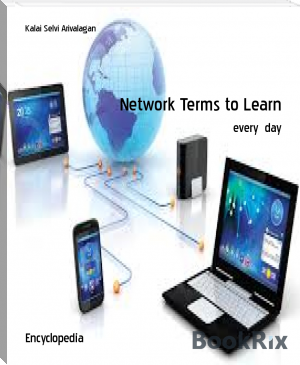Network Terms to Learn by Kalai Selvi Arivalagan (top android ebook reader TXT) 📕

Read free book «Network Terms to Learn by Kalai Selvi Arivalagan (top android ebook reader TXT) 📕» - read online or download for free at americanlibrarybooks.com
- Author: Kalai Selvi Arivalagan
Read book online «Network Terms to Learn by Kalai Selvi Arivalagan (top android ebook reader TXT) 📕». Author - Kalai Selvi Arivalagan
Amdahl's Law
Amdahl's law, named after a computer architect named Gene Amdahl and his work in the 1960s, is a law showing how much latency can be taken out of a performance task by introducing parallel computing. In parallel computing, Amdahl's law is mainly used to predict the theoretical maximum speedup for program processing using multiple processors. This term is also known as Amdahl’s argument.
Color Saturation
Color saturation refers to the intensity of color in an image. As the saturation increases, the colors appear to be more pure. As the saturation decreases, the colors appear to be more washed-out or pale. A highly saturated image has vivid, rich and bright colors, while an image with a low saturation will veer towards a scale of grey. In most monitor devices, televisions and graphic editing programs there’s an option to increase or decrease saturation. Color saturation ultimately is one of the three color properties, the other two being hue and value. Saturation is sometimes called “chroma” although the two terms have a slightly different meaning. While chroma defines the brilliance of a color in absolute terms according to the Munsell Color System, saturation is relative to pure gray. However, in nearly all instances, this difference is quite negligible in practice.
Static Method
In Java, a static method is a method that belongs to a class rather than an instance of a class. The method is accessible to every instance of a class, but methods defined in an instance are only able to be accessed by that object of a class. A static method is not part of the objects it creates but is part of a class definition. Unlike instance methods, a static method is referenced by the class name and can be invoked without creating an object of class. In simpler terms, they are methods that exist even if no object has been constructed yet and that do not require an invocation object.
Digital Video Broadcasting
Digital video broadcasting (DVB) is a standard for digital television and video that is used in many parts of the world. Various DVB standards cover satellite, cable and terrestrial television as well as video and audio coding for file formats like MPEG. Digital video broadcasting may also be referred to as digital television.
Automatic Machine Learning
Automatic machine learning (AutoML) is a general discipline that involves automating any part of the entire process of machine learning application. By working with various stages of the machine learning process, engineers develop solutions to expedite, enhance and automate parts of the machine learning pipeline. Automatic machine learning is also known as automated machine learning.
Firewall
A firewall is software or hardware that can be configured to block data from certain locations, applications, or ports while still allowing relevant and necessary data to pass through. Firewalls are used to block unauthorized access to or from networks that have different levels of trust. They work by enforcing security policies and are used to prevent malicious actors from gaining access to private networks connected to the Internet. A firewall may be implemented through hardware, software or a combination of both.
Firewalls at the perimeter of a network can be augmented by Zero Trust policies to ensure network access is granted appropriately and securely at every access layer of the OSI Model.
Microservices
A microservice is a modular software component that does one defined job. Microservices, which have become the default architecture for software development, can run as a process on an application server, virtual machines (VM) or container. Each microservice is a mini-application that has its own business logic and adapters for carrying out functions such as database access and messaging. The resulting application will have small, loosely-coupled components that communicate with each other using lightweight communication protocols. Microservices typically communicate with each other using Application Programming Interfaces (APIs).
Communication Streaming Architecture (CSA)
Communication Streaming Architecture (CSA) is a communication interface developed by Intel that links the memory controller hub (MCH) on the chipset to the network controller. The device is an individualized connection that does not use the peripheral component interconnect (PCI) bus on the input/output (I/O) controller hub. The CSA offloads network traffic from the PCI bus and reduces bottlenecks by freeing up bandwidth for other I/O processes. The CSA was only used for the Intel chipset that was manufactured in 2003. It was discontinued a year later and replaced by the PCI Express.
Computer-Mediated Communication
Computer-mediated communication (CMC) is a process in which human data interaction occurs through one or more networked telecommunication systems. A CMC interaction occurs through various types of networking technology and software, including email, Internet Relay Chat (IRC), instant messaging (IM), Usenet and mailing list servers. CMC technology saves time and money in IT organizations by facilitating the use of all communication formats.
Real Time Streaming Protocol
Real Time Streaming Protocol (RTSP) is a protocol which provides framework for real time media data transfer at the application level. The protocol focuses on connecting and controlling the multi data delivery sessions on lines of time synchronization for continuous media like video and audio. In short, real time streaming protocol acts as a network remote control for real time media files and multimedia servers. Real Time Streaming Protocol is also known as RFC 2326.
Stream Control Transmission Protocol
The Stream Control Transmission Protocol (SCTP) association is an SCTP endpoint uniquely identified by transport addresses. Only one SCTP association occurs between two endpoints at a time. The SCTP protocol is specified by RFC 4960, which updates RFC 2960 and RFC 3309.
Stream Control Transmission Protocol Endpoint
The Stream Control Transmission Protocol (SCTP) endpoint is an SCTP designated packet sender or receiver with eligible combined and unique transport addresses. SCTP endpoint addresses may not be used by other SCTP endpoints. SCTP enables single endpoint capability for multiple Internet Protocol (IP) addresses known as multi-homing. This provides better data survivability during network failure. SCTP multi-homing is only used for redundancy.
Internet Streaming Media Alliance
The Internet Streaming Media Alliance (ISMA) was a nonprofit corporation operating in the early 21st century to help standardize and explore open standards for streaming media. ISMA was a corporate collective, with participants such as Apple, Cisco and Sun Microsystems.
Deep Learning
Deep learning is a collection of algorithms used in machine learning, used to model high-level abstractions in data through the use of model architectures, which are composed of multiple nonlinear transformations. It is part of a broad family of methods used for machine learning that are based on learning representations of data.
Advance Encryption Standard
The Advanced Encryption Standard (AES) is a symmetric-key block cipher algorithm and U.S. government standard for secure and classified data encryption and decryption. In December 2001, the National Institute of Standards (NIST) approved the AES as Federal Information Processing Standards Publication (FIPS PUB) 197, which specifies application of the Rijndael algorithm to all sensitive classified data. The Advanced Encryption Standard was originally known as Rijndael.
Encryption Algorithm
An encryption algorithm is a component for electronic data transport security. Actual mathematical steps are taken and enlisted when developing algorithms for encryption purposes, and varying block ciphers are used to encrypt electronic data or numbers. Encryption algorithms help prevent data fraud, such as that perpetrated by hackers who illegally obtain electronic financial information. These algorithms are a part of any company’s risk management protocols and are often found in software applications.
Hybrid Encryption
Hybrid encryption is a mode of encryption that merges two or more encryption systems. It incorporates a combination of asymmetric and symmetric encryption to benefit from the strengths of each form of encryption. These strengths are respectively defined as speed and security. Hybrid encryption is considered a highly secure type of encryption as long as the public and private keys are fully secure.
Robotic Process Automation (RPA)
Robotic process automation (RPA) is the practice of automating routine business practices with software agents (bots) that perform tasks automatically. RPA programming plays an important role in data preprocessing and can be thought of as a more sophisticated version of macros. In the past, if an electronic form was missing a price, traditional automation software would flag the form as having an exception and issue an alert. An employee on the receiving end of the alert would then handle the exception by looking up the correct price and entering it manually on the form. With RPA technology, however, the software is able to look up the missing information and complete the form without human assistance.
Today, RPA technology is one of the fastest growing categories of enterprise application automation and sophisticated RPA bots can be taught a workflow that encompasses multiple steps, including:
Receiving forms. Issuing a receipt for the form. Checking the form for completeness. Filling in missing information. Forwarding a completed, validated form to its next destination.
Wireless Bridge
A wireless bridge is a type of networking device that enables an over-the-air connection between two different segments of a local area network (LAN). Wireless bridges use radio signals in the microwave or laser spectrum to provide fixed wireless access. A wireless bridge, which may also be referred to as a Wi-Fi bridge, works much like a wired network bridge. They play an important role in connecting LAN segments that are logically separated or located in different physical locations.
Narrow Artificial Intelligence
Narrow artificial intelligence (narrow AI) is a specific type of artificial intelligence in which a learning algorithm is designed to perform a single task, and any knowledge gained from performing that task will not automatically be applied to other tasks. Unlike general artificial intelligence, which seeks to mimic complex thought processes, narrow AI is designed to successfully complete a single task without human assistance. Popular applications for narrow AI include language translation and image recognition. Most AI applications in use today can be categorized as being narrow AI. Narrow AI may also be referred to as weak AI.
Quantum as a Service (QaaS)
Quantum as a service (QaaS) is a cloud service that provides customers with access to quantum computing platforms over the internet. QaaS uses the software as a service (SaaS) delivery model. Quantum computing is based on the qubit, which can superimpose binary positions and support artificial intelligence (AI) beyond today's narrow AI functionality. An important goal of quantum computing is to make artificial general intelligence a reality.
Although much of the theory and operational detail has been solved for quantum computing, business use for this type of computing is still very expensive. The QaaS model allows researchers to experiment with quantum computing on an on-demand basis with minimal financial output.
Cloud Application Programming Interface (Cloud API)
When a cloud provider creates an application or service, they also create APIs so that other software can communicate with that software or service.
Cloud API protocols
The protocols that support Cloud APIs include:
REST -- RESTful APIs use the HTTP protocol to perform functions such as creating, reading, updating, archiving and deleting records.
GraphQl -- GraphQL pulls all relevant data from multiple sites with a single request.
SOAP (Simple Object Access Protocol) -- SOAP APIs use the XML protocol to transfer data.
JSON-RPC -- This type of remote procedure call uses JSON formatting instead of XML to transfer data.





Comments (0)